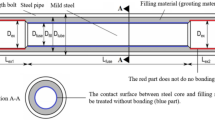Abstract
Mechanical properties of a dual-phase steel of 0.8 mm thickness are investigated with uniaxial tensile loadings at room temperature. Standard tensile tests are conducted to determine Young’s modulus, flow curves and plastic strain ratios in rolling, transverse and diagonal directions, respectively. Moreover, uniaxial tensile loadings with unloading–reloading cycles are performed to determine the elastic modulus evolution. Anisotropy of DP600 steel is described using isotopic hardening plasticity in junction with Hill’s orthotropic yield function and applied in finite element (FE) stamping analysis of an automotive structural member. In sheet metal deformation modeling, material models with both constant and variable Young’s moduli were considered to assess the effect of stiffness degradation on FE springback predictions. Effective plastic strain and part thickness distributions calculated with both models were fairly similar and maximum differences were determined to be 4 and 6 %, respectively. A similar situation holds for predicted springback distributions, but springback magnitudes calculated with variable modulus model were constantly higher. Computed geometries with both FE models were, furthermore, evaluated with surface scanning of manufactured parts. While stamping geometries predicted with both models underestimate actual shape distortions determined in manufactured parts, calculations with variable modulus have reduced maximum geometric deviation by 20 % and constantly improved shape correlation.

Similar content being viewed by others
References
Vehicle Crashworthiness and Occupant Protection. Auto/Steel Partnership & American Iron and Steel Institute, Southfield (2004)
Lightweight Rear Chassis Project Report. Auto/Steel Partnership & American Iron and Steel Institute, Southfield (2008)
Mowrtage W.: Low-rise 3D panel structures for hot regions: design guidelines and case studies. Arab. J. Sci. Eng. 37(3), 587–600 (2012)
Murali, G.; Gopal, M.; Rajadurai, A.: Effect of circular and rectangular drawbeads in hemispherical cup forming: finite element analysis and experimental validation. Arab. J. Sci. Eng. 37(6), 1701–1709 (2012)
Sadagopan, S.; Urban, D.: Formability characterization of a new generation high strength steels. American Iron and Steel Institute, Pittsburgh (2003)
Roll K., Weigand K.: Tendencies and new requirements in the simulation of sheet metal forming processes. Comput. Methods Mater. Sci. 9, 12–24 (2009)
Automotive Steel Design Manual. Auto/Steel Partnership & American Iron and Steel Institute, Southfield (2002)
Haddadi, H.; Bouvier, S.; Levée, P.: Identification of a microstructural model for steels subjected to large tensile and/or simple shear deformations. J. Phys. IV(11), 329–337 (2001)
Chun, B.K.; Jinn, J.T.; Lee, J.K.: Modeling the Bauschinger effect for sheet metals, part I: theory. Int. J. Plast. 18, 571–595 (2002)
Sung, J.H.; Kim, J.N.; Wagoner, R.H.: A plastic constitutive equation incorporating strain, strain-rate, and temperature. Int. J. Plast. 26(12), 1746–1771 (2010)
Firat, M.: U-channel forming analysis with an emphasis on springback deformation. Mater. Des. 28, 147–154 (2007)
Wagoner, R.H.; Li, M.: Simulation of springback: through-thickness integration. Int. J. Plast. 23(3), 345–360 (2007)
Yoshida, F.; Uemori, T.: A model of large-strain cyclic plasticity describing the Bauschinger effect and work hardening stagnation. Int. J. Plast. 18, 661–686 (2002)
Haddadi, H.; Bouvier, S.; Banu, M.; Maier, C.; Teodosiu, C.: Towards an accurate description of the anisotropic behaviour of sheet metals under large plastic deformations: modelling, numerical analysis and identification. Int. J. Plast. 22, 2226–2271 (2006)
ASTM Standard E8-01. Standard Test Methods for Tension Testing of Metallic Materials. ASTM International, West Conshohocken (2001)
ASTM Standard E517. Standard Test Method for Plastic Strain Ratio r for Sheet Metal. ASTM International, West Conshohocken (2010)
Banabic, D.; Bunge, H.J.; Pohlandt, K.; Tekkaya, A.E.: Formability of Metallic Materials, Springer, Berlin (2000)
Hallquist, J.O.: Ls-Dyna Theory Manual. LSTC, Livermore (2006)
Nine H.D.: The applicability of Coulomb’s friction law to drawbeads in sheetmetal forming. J. Appl. Metal Work. 2(3), 200–210 (1982)
Author information
Authors and Affiliations
Corresponding author
Rights and permissions
About this article
Cite this article
Ozsoy, M., Esener, E., Ercan, S. et al. Springback Predictions of a Dual-phase Steel Considering Elasticity Evolution in Stamping Process. Arab J Sci Eng 39, 3199–3207 (2014). https://doi.org/10.1007/s13369-013-0910-9
Received:
Accepted:
Published:
Issue Date:
DOI: https://doi.org/10.1007/s13369-013-0910-9




